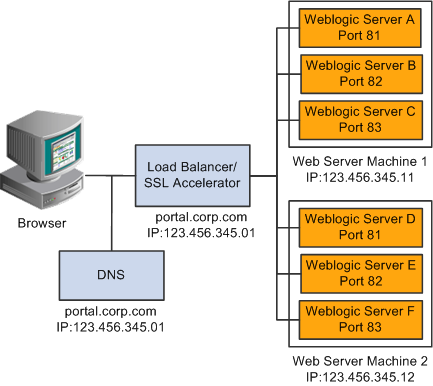Applying Load Balancing
Image: Example of load balancing
You can apply load balancing to a portal by using a hardware load-balancing solution to distribute load across multiple instances of the web server on multiple web server machines. Many of today’s hardware load balancers have SSL accelerating options that you should also consider. The number and size of web server machines and the number of web server instances per machine vary and determine load-balancing requirements and hardware selection. This diagram shows a possible load-balancing setup:

The hardware load balancing solution must be configured to enable sticky sessions, which ensures that all requests from a user’s browser session are delivered to the same web server session. In the example previous diagram, if the initial request from the browser was directed to Oracle WebLogic Server F, then all subsequent requests from that browser session must be directed to the same instance of Oracle WebLogic.
Keep multiple web server sessions on a single machine to keep the heap size of the Java Virtual Machine manageable and to allow the Java garbage collection to work optimally.
Hosts File Configuration
The hosts file on the portal web server machines in the previous diagram—which we'll call portalws1 and portalws2—must have an entry that directs DNS requests for the portal content provider server name (portal.corp.com) to the portal web server (123.456.345.11 on portalws1). This allows the portal to request content hosted on the same server directly without going back through the load balancer.
This is an example hosts file on portalws1.corp.com:
123.456.345.11 portal.corp.com
123.456.345.11 portalws1.corp.com